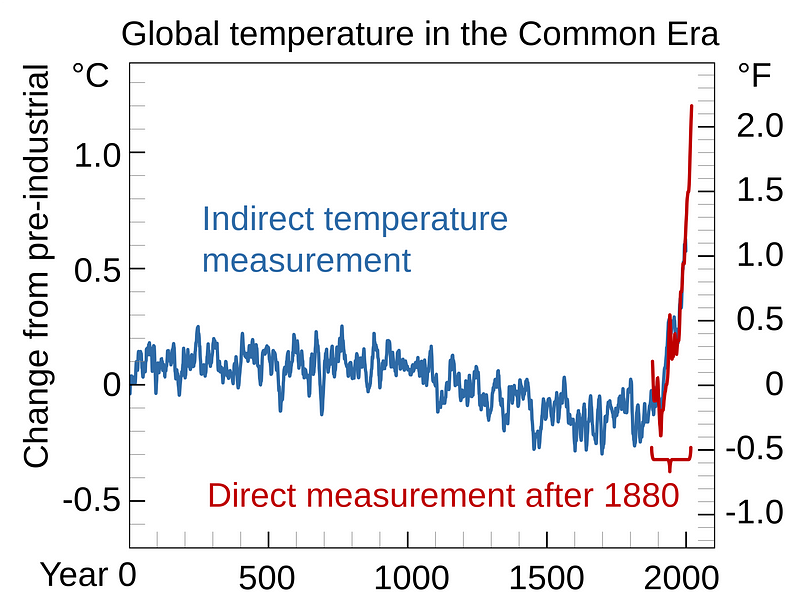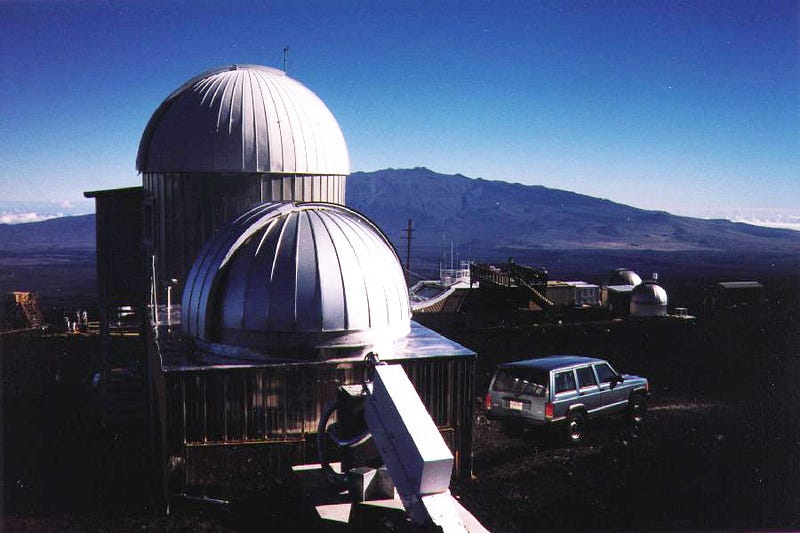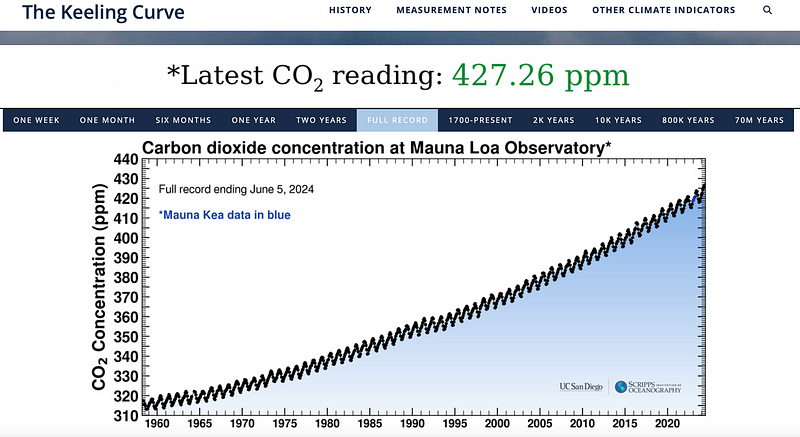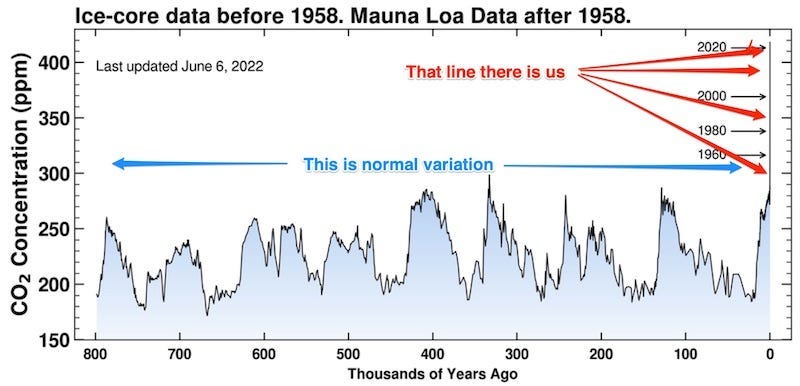Understanding Climate Change: Are We Facing Irreversible Consequences?
Written on

About a year ago, I penned an article titled “Global CO2 levels are still rising, have reached new record high.” At that time, I noted that CO2 levels had hit an astonishing 421.18 ppm.
Fast forward to today.
With numerous solar panels and wind turbines being installed, one might expect a decline in CO2 levels, right?
Unfortunately, that's not the case. The statement from last year still holds true: we've reached yet another record high for CO2.
In short, it’s incredibly frustrating.
Let’s break it down step by step.
While this may sound familiar from a year ago, it’s crucial information that deserves repetition due to its importance.
The Mauna Loa Observatory & The Keeling Curve

Situated on the Hawaiian island of Mauna Loa, the Mauna Loa Observatory has been diligently measuring atmospheric CO2 levels since 1958. This facility, established by scientist Charles Keeling, is located at an elevation of 11,145 feet, about three miles north of the summit.
Why this location?
It’s distanced from any continent, providing a representative sample of the central Pacific air. Furthermore, its high altitude helps avoid pollution trapped in the inversion layer, ensuring accurate measurements. Plus, a pre-existing military road makes access easier.
This site is ideal for data collection, supported by other facilities such as the Mauna Loa Solar Observatory, which also hosts the AMiBA cosmic microwave background observatory.
The data collected by Charles Keeling has resulted in what is now known as the Keeling Curve.
Here are the latest measurements (linked live data updated daily).
As of this writing, the recorded data shows…

What does the Keeling Curve reveal?
One notable feature of the Keeling Curve is its seasonal fluctuations. This is primarily due to the growth of vegetation in the Northern Hemisphere during summer, which absorbs CO2. Since most of the Earth's landmass is situated in the Northern Hemisphere, this seasonal variation typically reaches about 5 ppmv annually.
Another alarming observation is the rapid increase of CO2 levels. From an initial measurement of 313 ppmv in March 1958, levels have surged from 421.18 ppmv last year to 427.26 ppmv today.
This upward trend continues.
We are now breathing air that contains unprecedented levels of CO2.
Isn’t this just a minor issue?
Regrettably, it is a significant issue.
CO2 is classified as a greenhouse gas, capable of absorbing and re-emitting infrared radiation.
The sun serves as the primary energy source, leading to an energy balance.
What does this mean?
We receive energy from the sun, and in turn, emit energy back into space. The difference between these two is referred to as the energy balance.
An increase in CO2, a greenhouse gas, results in more energy being trapped, thus altering that energy balance.
In essence, denying climate change is not merely a difference of opinion; it's a challenge against the fundamental laws of physics.
Some may attempt to argue otherwise, often motivated by fossil fuel interests, but this is a contest no one can win.
Do we only see seasonal variations, or are there other long-term climate changes?
Indeed, we do observe longer-term climate variations.
Some argue that Earth’s climate has always experienced natural fluctuations, including ice ages followed by warm periods, suggesting that current changes are merely part of this cycle and not a cause for concern.
While it's true that natural variations exist, today's warming is unlike historical patterns.
This is illustrated by data spanning over 800,000 years.
Ice cores extracted from Greenland and Antarctica contain tiny bubbles of ancient air, allowing us to measure CO2 levels dating back that far.
When combined with Keeling data, this paints a clearer picture…

What causes these normal variations?
Earth’s orbit around the sun isn't static; it changes.
Gravitational forces from other celestial bodies lead to variations in our orbital path, ranging from near-circular to elliptical shapes. These variations, known as Milankovitch cycles, were proposed by Serbian geophysicist Milutin Milankovi? in the 1920s, theorizing their impact on long-term climate changes.
Essentially, these orbital variations alter the amount of solar radiation Earth receives, leading to natural oscillations in atmospheric CO2 levels, typically occurring roughly every 100,000 years.
However, as the chart illustrates, we've disrupted this cycle.
Experts in this field are understandably alarmed.
The rapid increase in CO2 has propelled our climate system into uncharted territory.
There’s an old adage inspired by Kipling’s 1895 poem “If”: If you can remain calm while everyone around you panics, then clearly, you’ve missed something significant.
The scientific community, particularly climate scientists with access to comprehensive data, are genuinely concerned.
We cannot escape this reality in the long term.
Climate change represents the most significant threat our species has ever faced.
Are we doomed?
This is the crucial question.
Life will persist, but without intervention, our future may not include humanity.
As demonstrated, CO2 levels from fossil fuel emissions are still rising, setting new records. If we don’t change our trajectory, we are indeed in serious trouble.
We have already committed to a drastically altered planet.
However, there are viable solutions and reasons for hope. Here are a few examples:
- Jun 2: Breakthrough in Carbon Capture: MOF-525 Can Capture and Convert CO2 into Useful Chemicals.
- May 28: Analysis suggests that China's CO2 emissions may have peaked in 2023.
- May 21: Ships could potentially store their CO2 emissions in the ocean.
Yet, certain outcomes are unavoidable:
- Sea levels are rising and will continue to do so — that is already a certainty.
- Temperatures are increasing, leading to regions becoming uninhabitable.
In the long term, familiar coastal cities may vanish, prompting mass migrations and food supply issues.
If we strive for change, we may slow down the process enough to adapt. Conversely, if we continue on our current path, the changes will be so rapid that adaptation will be impossible.
The key takeaway is that we still have options.
One last thought: It’s astonishing that voters in Florida support individuals like Ron DeSantis, who, in a display of scientific ignorance, recently enacted a law to erase “climate change” from state statutes, effectively committing Florida to fossil fuel dependency.
Given that much of Florida is at or near sea level, decisive action is crucial; otherwise, residents will need to prepare for rising waters.
In our current reality…
> Water in the Atlantic and Caribbean has already reached temperatures typically seen at the peak of hurricane season in August and September. This forecast spells trouble for a summer where the National Oceanic and Atmospheric Administration (NOAA) anticipates up to 25 named tropical storms, including four to seven major hurricanes with winds exceeding 111 mph (179 km/h).
Due to climate change, we now face an 85% chance that this could be one of the most intense and perilous Atlantic hurricane seasons on record.